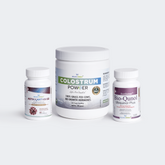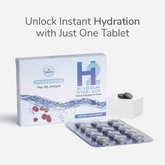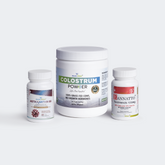Estimated Reading Time: 5 minutes
|Ever feel like your body needs a recharge but prefer natural options over synthetic supplements? You're not alone.
With so many health products out there, it’s hard to know what’s real and what’s just hype. That’s where fulvic acid comes in. It’s not new, but it’s getting a lot of attention lately—and for good reason.
Fulvic acid is a natural compound that forms when plants and minerals break down in soil over time. It might sound earthy (and it is), but it’s packed with good stuff—like trace minerals, antioxidants, electrolytes, and amino acids. These nutrients can help support your energy, gut health, skin clarity, and even your immune system.
So, if you’ve been looking for a simple, natural way to feel more energized, improve digestion, or give your skin a little glow-up, fulvic acid might be worth a closer look.
Here’s what we’ll cover:
-
What exactly is fulvic acid?
-
What are the health benefits?
-
Is it safe, and how much should you take?
-
And many more…
Let’s dive in and see if fulvic acid deserves a spot in your wellness routine.
What Is Fulvic Acid?
Fulvic acid is a humic substance. It is formed when organic matter, such as plants, breaks down over time in soil, compost, or streams. Moreover, it is also found in Shilajit, a sticky tar-like substance used for centuries in Ayurvedic medicine.
The following are what fulvic acid contains:
-
Trace minerals like zinc, magnesium, and iron
-
Amino acids for tissue repair
-
Antioxidants to fight oxidative stress
-
Electrolytes for cellular hydration
Good to Know: Fulvic acid has good absorption power. It helps shuttle nutrients directly into your cells, allowing your vitamins and minerals to work more effectively and efficiently.
Fulvic Acid Chemical Composition
Fulvic acid isn’t just one molecule—it’s a mix of many organic compounds that form when plants and microbes break down over time. Its molecular weight varies significantly, but a commonly reported formula is C₁₃₅H₁₈₂O₉₅N₅S₂ (although this varies depending on the source material and extraction method).
Here's what makes it special:
-
Carboxyl Groups (-COOH): These acidic parts help fulvic acid dissolve in water—no matter the pH level.
-
Phenolic and Hydroxyl Groups (-OH): These boost its antioxidant power and ability to bind to minerals.
-
Carbonyl Groups (C=O): Found in ketones and aldehydes, they add to its reactivity and structure.
-
Benzene Rings (Aromatic Rings): These ring-shaped structures (connected by oxygen bridges) give fulvic acid stability and biological activity.
Fun Fact: Fulvic acid is rich in carbon, hydrogen, and oxygen. It may also contain small amounts of nitrogen and sulfur, depending on its origin.
Compared to humic acid (another type of humic substance), fulvic acid is:
-
Smaller in size
-
More oxygen-rich
-
Easier for the body to absorb

Fulvic Acid Benefits: Why People Are Talking About It
1. Improves Gut Health
If you’ve been experiencing bloating, irregularity, or discomfort, fulvic acid may help. It supports:
-
Growth of good gut bacteria
-
Repair of the intestinal lining
-
Nutrient breakdown and absorption
2. Enhances Nutrient Uptake
Think of fulvic acid as a nutrient taxi—it binds with minerals and vitamins and delivers them straight into your cells. This may help your body:
-
Better utilize supplements
-
Improve hydration
-
Boost energy levels naturally
3. Supports Cognitive Health
Some early research suggests that fulvic acid may:
-
Slow the aggregation of tau proteins linked to Alzheimer’s
-
Improve focus and clarity
-
Protect neurons from damage
A small study even showed that Shilajit, which contains fulvic acid, helped stabilize brain function in people with cognitive issues.
4. Boosts Immunity
Fulvic acid may help regulate your immune system. It’s been shown to:
-
Reduce inflammation
-
Supports white blood cell function
-
Lower allergy sensitivity
It works best as part of a complete wellness routine. For maximum support, pair it with gut-friendly detox methods.
5. Improves Skin Appearance
Topical forms of fulvic acid are gaining traction for:
-
Calming eczema and acne
-
Reducing redness and irritation
-
Smoothing out fine lines
You’ll spot it in many natural skincare products for a good reason.
Is Fulvic Acid Safe?
For most people, fulvic acid is safe when used properly.
Safe If:
-
Taken in small doses (up to 500 mg/day)
-
Sourced from purified, reputable brands
-
Used topically for short periods (up to 4 weeks)
Avoid If:
-
You’re pregnant or breastfeeding
-
You have autoimmune conditions (like lupus or RA)
-
You live in areas with low selenium (risk of Kashin-Beck disease)
Side Effects to Know
Most side effects are rare and mild, especially when the medication is first started.
Common symptoms:
-
Headaches
-
Nausea
-
Diarrhea
-
Sore throat
-
Fatigue
These may be a sign of detox—they typically pass in a few days.
Fulvic Acid Dosage: How Much Should You Take?
There’s no “one-size-fits-all,” but here are typical amounts:
Oral Supplements
-
Liquid: 10–15 drops in water once a day
-
Capsules: 250–500 mg daily
-
Shilajit resin: 500 mg daily
Take it on an empty stomach, 30 minutes before or 2 hours after meals or medications.
Topical Use
-
Choose creams with 4.5-5% fulvic acid
-
Apply twice daily to affected areas
Important Note: Always read the label. If you’re unsure, check with a healthcare provider.
Important Precautions and Interactions
Fulvic acid is natural, but it can interact with medications.
May Interact With:
-
Blood thinners (increased bleeding risk)
-
Thyroid medications (may affect hormone levels)
-
Immunosuppressants (could reduce effectiveness)
Also, avoid mixing with tap water—chlorine may cancel out the benefits.
What to Look For in a Fulvic Acid Supplement
Not all fulvic acid products are created equal. Here’s how to choose a good one:
Look for:
-
Third-party testing (for heavy metals & bacteria)
-
Purified, organic sources
-
Clear labeling of ingredients
-
Ethically sourced
Avoid:
-
Raw or unprocessed Shilajit
-
Supplements without lab verification
High-quality fulvic acid should be odorless, golden brown, and fully water-soluble.
Common Myths—Busted
Let’s set the record straight:
-
Myth: All fulvic acids are the same
Truth: Quality and composition vary by source.
-
Myth: It’s just for plants
Truth: It’s beneficial for humans, too, when purified.
-
Myth: More is better
Truth: Overuse may lead to side effects. Always follow dosage instructions.
Final Thoughts
Fulvic acid isn’t just a buzzword—it’s a naturally occurring compound with real, science-backed potential. Whether you’re aiming for better digestion, sharper focus, or a healthier glow, it might be worth exploring.
Just remember:
-
Stick with purified, high-quality products
-
Start small, and watch for any side effects
-
Talk to your doctor if you’re on medications or have a health condition
When used smartly, fulvic acid could become your new favorite wellness tool.
Disclaimer: This content is for informational purposes only and is not a substitute for medical advice. Always consult your healthcare provider before starting any supplement.
References
-
Dekker, J., Medlen, C.E. and Ltd, E.P. (1998) US6569900B1 - Fulvic acid and its use in the treatment of various conditions - Google Patents. https://patents.google.com/patent/US6569900B1/en.
-
FULVIC ACID: Overview, uses, side effects, precautions, interactions, dosing, and reviews (no date). https://www.webmd.com/vitamins/ai/ingredientmono-1320/fulvic-acid.
-
Smith, C. (2024) How fulvic acid improves hydration and nutrient absorption. https://fulvicxcell.com/blogs/news/how-fulvic-acid-improves-hydration-and-nutrient-absorption.
-
The Editors of Encyclopaedia Britannica (1998) Fulvic acid | humic substances, soil fertility, plant nutrition. https://www.britannica.com/science/fulvic-acid.









![Top 5 Best Vitamins for Men in Their 30s [Backed by Science!]](http://wellnessextract.com/cdn/shop/articles/Vitamin_for_men_8fe0fe21-19b1-4020-b895-dc104449637e_165x.webp?v=1765878148)




























